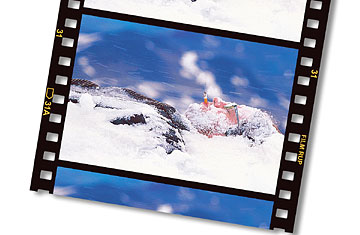
Walking through downtown Reykjavík on a November night is a little like being trapped in a snow globe that's packed away in the world's attic. The gray sky hangs low, dusting the houses in white soundproofing. The narrow streets, glazed by the orange glow of streetlamps, are invariably empty. In the 2000 film 101 Reykjavík, the film's narrator puts it this way: "Reykjavík is like some kind of Siberia in the winter. Even the ghosts are bored here."
It's also the best time of year to drop by. Not only is winter the cheapest time to get to this expensive Nordic nation, 101, the postal code and nickname of the capital city's oldest neighborhood, is at its best in its darkest and coldest moments, when its back alleys, mom-and-pop fishmongers and bite-size pubs tap into the charisma of one of Europe's most storied neighborhoods. Indeed, 101 has been the muse for a generation of artists that love to hate Iceland's six-month winters — among them director Baltasar Kormákur, whose film 101 Reykjavík was based on Hallgrímur Helgason's 1996 novel of the same name.
101 Reykjavík is the story of Hlynur, a 30-year-old slacker who lives with his divorced mother in their cramped 101 apartment. She still buys him underwear; he smokes weed with her in the evenings. Eventually, Hlynur's mom comes out of the closet and takes a lover — a free-spirited flamenco dancer — whom Hlynur falls for, too. The story of their triangle unfolds against snow-covered streets and alternating cozy and claustrophobic interiors, in loving tribute both to the neighborhood and its seasonal ritual of drinking to excess. "Life is one week," Hlynur says as the film opens. "I drop dead every weekend."
In both celebrating and condemning the nihilistic flag flown by Reykjavík's listless postyouths, Kormákur managed to capture the city's brand of self-deprecating cool before it joined Björk as a cultural export. Today, you won't find too many Icelanders moaning so publicly about their dark, isolated lot in life. But you will find the spots where Hlynur and his friends live out their days of beer, cigarettes and one-night stands. Chief among them is Kaffibarinn, the pub at the fulcrum of the movie's social world, which still challenges its guests to hone the skill of keeping a full pint from spilling in a swaying crowd. By day, twentysomethings sporting hoodies and complicated haircuts tap away on laptops next to pots of muddy coffee. At night, they reconvene — with beer and a DJ — to fortify themselves against the 36F (2C) temperatures and get over Reykjavík's claustrophobia (it's a city of just 117,000). In November, days are roughly six hours long, which means Friday night starts early and goes very, very late.
If you manage to pull yourself out from under your duvet before sunrise at 10 a.m., you would do well to spend the dark hours of morning in one of the neighborhood's fantastic cafés, like the basement-level Grai Kotturinn (the Gray Cat) or Mokka, where the grease shadows of decades of visitors mark the old wood-paneled walls. If it's a weekend, stop by Kolaportid, the old flea market that also makes a cameo in 101, where merchants from outside the city go to gossip over coffee and doughnuts and sell their wares. There aren't a lot of places in the world where you can buy guillemot eggs, whale, vinyl records and old Icelandic textbooks under the same roof. By the time you're out, as the sun gets ready for its 3 p.m. retreat, head to Sundhöllin, the city's oldest and most beautiful bathing pool, where you can sit under the falling snow in an outdoor hot tub and think about whether you're going to do it all again that night.
After a few quiet days, 101 starts to feel a little less small — and even Hlynur's so-called life starts to make a little more sense. "You don't move around much, do you?" Lola, the flamenco dancer, asks Hlynur one night as they're heading out to the bar. "You know, there is more to the universe than 101 Reykjavík." That is certainly true, but it's not a bad place to get lost in for a few dark days and a few cold nights.